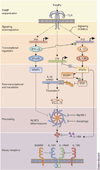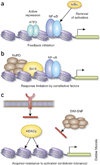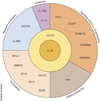Restraint of inflammatory signaling by interdependent strata of negative regulatory pathways
- PMID: 22990889
- PMCID: PMC4893774
- DOI: 10.1038/ni.2391
Restraint of inflammatory signaling by interdependent strata of negative regulatory pathways
Abstract
Activation of Toll-like receptor (TLR) signaling and related pathways by microbial products drives inflammatory responses, host-defense pathways and adaptive immunity. The cost of excessive inflammation is cell and tissue damage, an underlying cause of many acute and chronic diseases. Coincident with activation of TLR signaling, a plethora of anti-inflammatory pathways and mechanisms begin to modulate inflammation until tissue repair is complete. Whereas most studies have focused on the signaling components immediately downstream of the TLRs, this Review summarizes the different levels of anti-inflammatory pathways that have evolved to abate TLR signaling and how they are integrated to prevent cell and tissue destruction.
Figures



References
-
- Nathan C, Ding A. Nonresolving inflammation. Cell. 2010;140:871–882. - PubMed
-
- Bezbradica JS, Medzhitov R. Integration of cytokine and heterologous receptor signaling pathways. Nat Immunol. 2009;10:333–339. - PubMed
-
- Liew FY, Xu D, Brint EK, O'Neill LA. Negative regulation of toll-like receptor-mediated immune responses. Nat Rev Immunol. 2005;5:446–458. - PubMed
Publication types
MeSH terms
Substances
Grants and funding
LinkOut - more resources
Full Text Sources
Other Literature Sources

